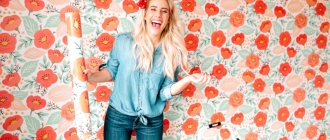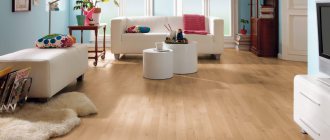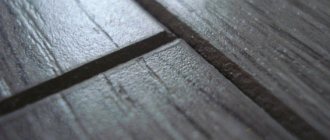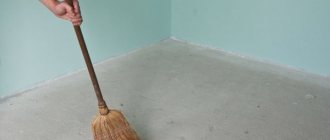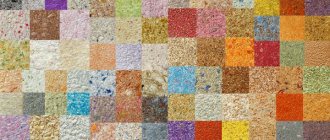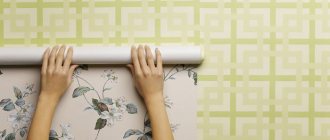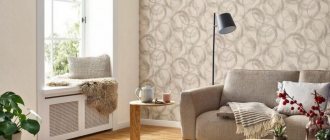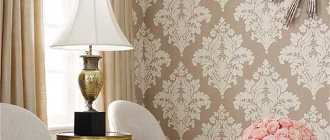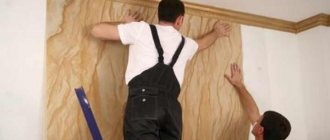During renovations in the house, many ambiguous situations arise that require resolution. For example, what comes first with wallpaper or laminate. Views on the answer to the question are divided, but both solutions have their advantages and disadvantages. Let's try to figure out what's good and what's not so good in this order: wallpapering, and then installing the laminate floor; Let's try to justify the answer to the question: what to do first - paste wallpaper or lay laminate.
What comes first: lay laminate flooring or wallpaper?
The sequence of technological processes during repair is ultimately determined by the degree of occurrence of dust and dirt at one or another stage of repair. Due to the fact that the laminated floor is laid and the wall covering is glued indoors in almost one final stage of repair, you should start with a step that will create dust, dirt, debris and can cause damage or harm to the finished coating.
The first priority procedure is usually the installation of flooring material, when such material is linoleum or parquet. So, when laying parquet, it is first installed with glue, after which sanding work can be carried out, but there is a huge risk of contamination of the new wallpaper if it has already been glued.
When working with linoleum, it is easy to damage the walls with wallpaper with a roll; when cutting near the walls, there may be a risk of snagging the wall finishing, so it would also be more correct to first lay the linoleum, and only then finish the walls with wallpaper material. We'll talk about laminated panels next.
When gluing wallpaper, it is easy to stain the slats with adhesive drips
First wallpaper, then laminate
Let's say that we will first glue the wallpaper, then lay the laminate. We do not take into account the preparatory work with the base; it is carried out earlier, before laying the laminated floor and gluing the wallpaper. During the installation of laminated panels, there is no accumulation of dust and dirt, and there is no risk of damaging or contaminating the wallpaper already pasted on the walls.
But when gluing wallpaper on the walls after the installation of a laminated floor has been completed, the laminate is noticeably affected by moisture evaporation when the wallpaper glue dries.
It is impossible not to take into account the fact that the wallpaper dries in a room without ventilation, with the windows and doors closed. A kind of steam room is formed inside; the laminated floor remains inside it for a certain period of time, and this is harmful for the laminate and can have consequences.
Of course, given the longer service life of the panels compared to wallpaper, in the future you will still have to stick new wallpaper with the covering lying on the floor. But, taking into account the cost of a laminated floor, I don’t want to subject it to such a difficult test again.
First lay the laminate, then glue the wallpaper
Arguing on the topic of what to do first: lay the laminate or glue the wallpaper, it is necessary to discuss the second option - laying the flooring first. You can immediately assume that with this method, the laminate floor will be stained with adhesive drips during the wallpapering process.
The solution is not difficult to find - cover the floor surface with a layer of plastic film. This will help protect the laminate floor from dust and adhesive drips that are always present when wallpapering is applied.
When working, you need to try not to damage the integrity of the polyethylene layer, for example, with a stepladder or a wallpaper knife. If you prefer to install slats first, you should not install skirting boards right away. Without them, gluing the wall covering is much easier.
Recommendations from experts
Experts recommend starting to prepare horizontal and vertical surfaces at the final stage of repair work. By this time, the redevelopment should be completed, window structures installed and elements of the heating system replaced.
Laminate flooring cannot be laid on bare concrete floors, so an underlay must be formed.
It can be made of the following materials:
- polyethylene;
- expanded polystyrene;
- cork base.
To simplify the process of laying the substrate, it is recommended to use adhesive tape, which is used to fix the sheets and thereby eliminate the risk of involuntary displacement. The joints between the panels are easy to hide when installing the elements perpendicular to the window opening.
To obtain a more durable connection, it is recommended to use locks or adhesive.
A small gap of no more than 1 cm is left between the wall and the last board. To better fit the panels, use bars and a hammer, and after laying the last row, the wedges are carefully removed. After completing the flooring work, you can begin installing the doors.
Recommended sequence of repair steps
The sequence of work supported by practice when installing laminated flooring material and wallpaper on walls:
- Wall preparation: removing old wallpaper with a special scraper or spatula. You can thoroughly moisten the old wallpaper with water, it will be easier to remove.
- After this, the walls are leveled, if necessary, with plaster and putty solutions.
- After the wall surfaces have dried, a cement screed is applied to level the floor.
Wallpaper and laminate in the interior
We figured out the sequence of work. Now let's look at several options for decorating the room from a design point of view.
Wallpaper and laminate: color combination
Laminated flooring materials are more often chosen, and wallpaper is more often used to decorate walls. Their colors and textures must be in harmony with each other, otherwise the overall interior of the room will not benefit.
Before choosing flooring, consider the style of the room to choose a laminate color group. There are a huge number of panel colors; they can be divided into large groups according to color scheme:
- white;
- red;
- grey;
- brown and dark (to black).
An important role is played by texture and theme: imitation of wood, stone, etc. You need to be able to correctly combine the colors of floor and wall coverings.
Best option:
combination of furniture, wall and floor coverings. This takes into account the dimensions, general illumination of the room, which side the windows are located on, etc. For example, if you want to see the room as bright, choose a light palette.
The basis for choosing colors can be the interior style:
- classic - characterized by a calm pattern and tones: for example, light walls and dark floors. Laminate imitates valuable wood and has warm tones;
- country - characterized by naturalness. The floor imitates old wood in a light color scheme, the color of the walls is slightly lighter than the floor (plain or with small patterns);
- modern - contrast is used: for example, black and white tones.
The black and white combination will visually increase the space. The predominance of black tone will make the room smaller.
Let's look at the most popular color combinations (how to combine laminate and wallpaper): Red laminate colors. Warm shades of wallpaper work well here:
- pale blue;
- pink;
- pale lilac;
- peach;
- calm yellow.
Brown laminate colors are the most popular. Pastel colors of wallpaper are suitable for brown laminate:
- cream;
- yellow;
- green;
- ocher.
Decorative elements and panels on the walls in dark brown frames successfully emphasize the nobility.
Light wallpapers are perfect for dark laminate flooring. The combination of dark laminate and light walls visually increases the space of the room. Light shades of laminate brighten dark rooms well. White looks chic and solid, but is not practical if there are pets or children in the apartment.
Choice of color combinations
In addition to the print format and color saturation, successful color combinations are also used to create a spectacular interior. Success means the use in decoration of colors that benefit from proximity, and their presence in certain proportions.
This table will help you avoid mistakes when designing a design - its columns group colors, the joint use of which ensures a harmonious range of cladding. The proximity of elements from different columns, as a rule, is less successful, although it is not excluded.
As for the proportions of the selected colors in the decoration, the recommendations are as follows. The color scheme of the room should contain no more than three basic colors (we are not talking about tones). And the proportions of the two or three colors used should not be equal, since these percentages - 50/50 or 33/33/33 - give the finish monotony and unpretentiousness. An asymmetrical color distribution, for example, 40/60 or 60/30/10, provides the interior with a certain emphasis and style.
However, while adhering to the recommendations of professionals, one should not neglect personal preferences - color perception can be individual, so you cannot blindly follow the advice, even of professionals.
How to choose wallpaper for laminate flooring
With the help of color design and different combinations of several color schemes inside the room, it is possible to expand or, conversely, narrow the space of the room, give it warmth or coolness. How to choose wallpaper for laminate, taking into account the characteristics of the premises?
To visually increase the space of the room, you can use a combination of light shades of wallpaper under a dark laminate. Thus, the floors will look solid and noble, and the walls will become light. Furniture for such a room can be selected in light colors, then it will contrast well with the dark floor.
White wallpaper combined with dark laminate
To visually make the room smaller, a combination is used: light laminate and dark wallpaper on the walls. If you want, on the contrary, to enlarge the room, give it lightness and light - combine light laminate and light wallpaper on the walls.
We must remember that: panels and wallpaper on the wall cannot be made in the same tone, there must be a difference of at least 2 tones, or it is worth using a baseboard in a contrasting color.
Preparing the base
It is permissible to lay laminate flooring on linoleum, parquet boards or other substrate, provided that the requirements for evenness, strength and moisture content of the substrate are met. The permissible floor difference should not exceed 3 mm per 1 m of base. Laying laminate flooring on carpet is not allowed, due to the electrostatic effect and possible problems with locks. If the laminate is laid on a concrete surface, the relative humidity should not exceed 2.5%. The floor must also be dry and hard.
When laying on a concrete surface, it is first necessary to lay a vapor barrier film or ordinary polyethylene with a thickness of 200 microns on it to protect it from moisture. Insulation is needed only for concrete floors; polyethylene does not need to be laid on a wooden base, plywood, chipboard or parquet.
When laying on a plank floor, it is necessary to deepen the heads of the nails with which the boards are nailed to the joists, and secure the “creaking floorboards” with screws. It is also necessary to secure the boards with screws in places of load, in doorways, near windows. In the future, this will avoid the appearance of unwanted squeaks.
